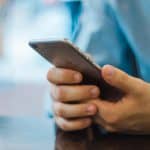As of May 2020, spending on food away from home was $20 billion below where spending was in January, according to Fortune.
While that’s actually an improvement on figures from earlier this year, in March and April, it still isn’t the rebound the restaurant industry is looking for. The road to recovery will be a long one, but restaurants are adjusting at a rapid clip to convince customers to come back. That includes implementing new dining policies, health and safety measures, limited menus, and outdoor dining.
But social distancing requirements still remain key and that’s where restaurants are looking to evolve with six-foot distancing protocols and limited contact. That gets trickier when you consider POS systems at most restaurants rely on a cashier and a physical transaction in a close space—something the Centers for Disease Control and Prevention is strongly discouraging.
So how can restaurant owners meet customers where they’re comfortable without physically meeting them? With contactless menu browsing, ordering, and payment systems.
These can help restaurants of all types avoid unnecessary points of contact while ensuring health and safety and increasing sales.
Here’s how it works.
No paper money is exchanged.
The concept behind contactless payment is that bills are paid virtually, via mobile devices, rather than exchanged hand-to-hand, thus avoiding the spread of germs and improving efficiency and speed. So how does that happen?
We’ll be focusing on on-premise dining, but it’s not just limited to that form of service.
Step 1) Mobile Menu Browsing
Guests pull up the restaurant menu by tapping or scanning a QR code on the table, and browse for their meal.
Step 2) Decide How to Order
Customer behaviors have changed since the start of the pandemic, and that means restaurants have had to change with them.
Some patrons might feel more comfortable ordering on-premise, in person, while others might want delivery, and still others prefer curbside service. OneDine can accommodate all of them. Here’s how.
In-Person
Restaurants can implement the orderable menu, tailored to let customers find the items they want quickly and choose from information like images, certain tags such as “gluten-free,” and nutritional data.
Once they know what they want, they can scan a QR code affixed wherever the restaurant prefers or tap a sensor to check-in. From there they can summon the waitstaff or view special offers, and close out with contactless payment.
Delivery
Use the browsable menu to see full offerings from an establishment and favorite items they think they might like.
Guests can pay online via their mobile devices so they don’t have to bother with money once their order arrives at their door.
Curbside
Customers can park, scan a QR code posted outside the restaurant using their mobile device, and from there be directed to the website to complete their order. After placing an order from the browsable or orderable menu, contactless payment and curbside pickup are a snap.
Thanks to OneDine’s data driven approach, restaurant owners don’t just benefit from the ease of use but are given loads of information in the process. This includes how long a customer has been waiting, whether or not they have paid, and specifics on where to deliver the food.
Make On-Premise Easier
And you can’t beat the speed: Guests can order and pay in less than 2 minutes.
Tap and Pay is a means by which restaurants can diminish touchpoints, thereby keeping their customers and staff safe from virus risks. With accessibility in mind, OneDine designed its Tap and Pay system to reach the most customers possible by making it usable from any smartphone. And that’s a lot of people. Currently, according to Pew Research, 5 billion people have smartphone devices.
Using QR Code technology, restaurants can apply QR codes to anything, be it a sticker on a table, a coaster, or a sign in the parking lot. Then a customer need only scan it to proceed with their transaction.
Plus, OneDine offers Pure Pay technologies with scan-to-pay and text-to-pay capabilities. Using Pure Pay, restaurant team members can send an SMS link to a customer’s mobile device. From there it will prompt the customer to pay via:
- Apple Pay
- Google Pay
- Credit Card
OneDine’s hardware installation is simple and inexpensive, allowing restaurants to get up and running swiftly.
For restaurants attempting to operate during the pandemic, offering contactless payment isn’t an option. It’s a requirement. And OneDine has a solution that can:
- Reduce labor costs
- Provide easy installation
- Improve branding
- Manage and expand reward programs
- Ensure safety with Text-to-Pay and Scan-to-Pay features
To begin evolving your restaurant for contactless on-premise dining, schedule a OneDine demo.





